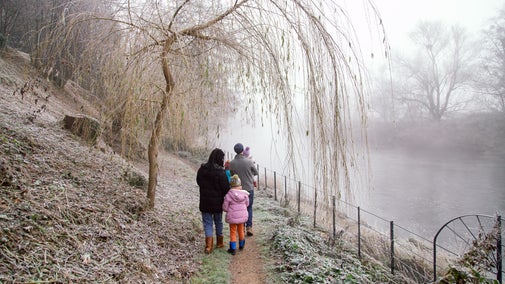Boundary walk at Hughenden
Oxfordshire, Buckinghamshire & Berkshire
This energetic 4-mile walk broadly follows the outer boundary of the Hughenden Estate. It allows you to explore beautiful woodland, open parkland, farmland and a rare chalk stream.
Near to
HughendenStart point
Visitor welcome kiosk, Hughenden, High Wycombe, Buckinghamshire HP14 4LA. Grid ref: SU859955.Trail information
How to follow the walk
In places, this walk is waymarked with red National Trust arrows, but you may find it more reliable to follow the route on a hand-held device, or to print out a copy of these directions to use as you walk.
More near here
Woodcock Wood walk at Hughenden
On this leisurely 1.2 mile walk, you'll loop around typical Chiltern farmland and woodland. Enjoy the peace and quiet of Woodcock Wood before heading back along 'Coffin Path'.

Hughenden's Monument walk
Discover a short 2-mile return walk with moderate hill climbs that takes in the monument at Hughenden. Take in far-reaching views from the monument which is known to be is one of the best look-out points the area.

Cookham and Cock Marsh walk
Enjoy stunning views across the Thames Valley while following riverside paths on the dog-friendly Cookham and Cock Marsh walk.

The long Wind in the Willows walk
A 5-mile walk along country lanes, woodland and the village of Cookham Dean that takes in places that inspired Wind in the Willows author Kenneth Grahame.

Get in touch
Our partners

We’ve partnered with Cotswold Outdoor to help everyone make the most of their time outdoors in the places we care for.
You might also be interested in
Eating and shopping at Hughenden
Enjoy light snacks, hot meals and drinks in the café, then have a browse in the shop or pick up a bargain in the second-hand bookshop.

Walking in Oxfordshire, Buckinghamshire and Berkshire
From gentle strolls for little legs to longer hikes through the rolling Chiltern hills, these are some of the best walks in Oxfordshire, Buckinghamshire and Berkshire.

Walking
Explore some of the finest landscapes in our care on coastal paths, accessible trails, woodland walks and everything in between. Find the best places to walk near you.

Follow the Countryside Code
Help to look after National Trust places by observing a few simple guidelines during your visit and following the Countryside Code.

Staying safe at National Trust places
The special places in National Trust care sometimes come with a few risks for visitors, be it coastline or countryside. Find out how to keep safe throughout your visits.

Cotswold Outdoor: our exclusive walking partner
Learn about the National Trust’s ongoing partnership with Cotswold Outdoor. Find out how they help us care for precious places and the exclusive discount available for National Trust supporters.


